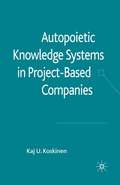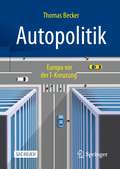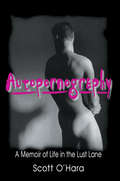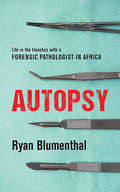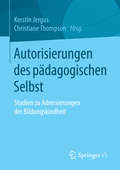- Table View
- List View
The Autopoiesis of Architecture, Volume I: A New Framework for Architecture
by Patrik SchumacherTake a theoretical approach to architecture with The Autopoiesis of Architecture, which presents the topic as a discipline with its own unique logic. Architecture's conception of itself is addressed as well as its development within wider contemporary society. Author Patrik Schumacher offers innovative treatment that enriches architectural theory with a coordinated arsenal of concepts facilitating both detailed analysis and insightful comparisons with other domains, such as art, science and politics. He explores how the various modes of communication comprising architecture depend upon each other, combine, and form a unique subsystem of society that co-evolves with other important autopoietic subsystems like art, science, politics and the economy. The first of two volumes that together present a comprehensive account of architecture's autopoiesis, this book elaborates the theory of architecture?s autopoeisis in 8 parts, 50 sections and 200 chapters. Each of the 50 sections poses a thesis drawing a central message from the insights articulated within the respective section. The 200 chapters are gathering and sorting the accumulated intelligence of the discipline according to the new conceptual framework adopted, in order to catalyze and elaborate the new formulations and insights that are then encapsulated in the theses. However, while the theoretical work in the text of the chapters relies on the rigorous build up of a new theoretical language, the theses are written in ordinary language ? with the theoretical concepts placed in brackets. The full list of the 50 theses affords a convenient summary printed as appendix at the end of the book. The second volume completes the analysis of the discourse and further proposes a new agenda for contemporary architecture in response to the challenges and opportunities that confront architectural design within the context of current societal and technological developments.
The Autopoiesis of Architecture, Volume II: A New Agenda for Architecture
by Patrik SchumacherThis is the second part of a major theoretical work by Patrik Schumacher, which outlines how the discipline of architecture should be understood as its own distinct system of communication. Autopoeisis comes from the Greek and means literally self-production; it was first adopted in biology in the 1970s to describe the essential characteristics of life as a circular self-organizing system and has since been transposed into a theory of social systems. This new approach offers architecture an arsenal of general comparative concepts. It allows architecture to be understood as a distinct discipline, which can be analyzed in elaborate detail while at the same time offering insightful comparisons with other subject areas, such as art, science and political discourse. On the basis of such comparisons the book insists on the necessity of disciplinary autonomy and argues for a sharp demarcation of design from both art and engineering. Schumacher accordingly argues controversially that design as a discipline has its own sui generis intelligence – with its own internal logic, reach and limitations. Whereas the first volume provides the theoretical groundwork for Schumacher’s ideas – focusing on architecture as an autopoeitic system, with its own theory, history, medium and its unique societal function – the second volume addresses the specific, contemporary challenges and tasks that architecture faces. It formulates these tasks, looking specifically at how architecture is seeking to organize and articulate the complexity of post-fordist network society. The volume explicitly addresses how current architecture can upgrade its design methodology in the face of an increasingly demanding task environment, characterized by both complexity and novelty. Architecture’s specific role within contemporary society is explained and its relationship to politics is clarified. Finally, the new, global style of Parametricism is introduced and theoretically grounded.
The Autopoiesis of Architecture, Volume II: A New Agenda for Architecture
by Patrik SchumacherThis is the second part of a major theoretical work by Patrik Schumacher, which outlines how the discipline of architecture should be understood as its own distinct system of communication. Autopoeisis comes from the Greek and means literally self-production; it was first adopted in biology in the 1970s to describe the essential characteristics of life as a circular self-organizing system and has since been transposed into a theory of social systems. This new approach offers architecture an arsenal of general comparative concepts. It allows architecture to be understood as a distinct discipline, which can be analyzed in elaborate detail while at the same time offering insightful comparisons with other subject areas, such as art, science and political discourse. On the basis of such comparisons the book insists on the necessity of disciplinary autonomy and argues for a sharp demarcation of design from both art and engineering. Schumacher accordingly argues controversially that design as a discipline has its own sui generis intelligence – with its own internal logic, reach and limitations. Whereas the first volume provides the theoretical groundwork for Schumacher’s ideas – focusing on architecture as an autopoeitic system, with its own theory, history, medium and its unique societal function – the second volume addresses the specific, contemporary challenges and tasks that architecture faces. It formulates these tasks, looking specifically at how architecture is seeking to organize and articulate the complexity of post-fordist network society. The volume explicitly addresses how current architecture can upgrade its design methodology in the face of an increasingly demanding task environment, characterized by both complexity and novelty. Architecture’s specific role within contemporary society is explained and its relationship to politics is clarified. Finally, the new, global style of Parametricism is introduced and theoretically grounded.
Autopoietic Knowledge Systems in Project-Based Companies
by K. KoskinenThis book gives an alternative observational scheme to better understand knowledge creation and learning in project-based companies. It builds upon emergent new ways of looking at projects which is important - as any discipline stays alive by reflection and re-framing ideas as they are challenged, argued and clarified.
Autopolitik: Europa vor der T-Kreuzung
by Thomas BeckerDie Automobilindustrie von heute ist das Ergebnis von einem Jahrhundert Automobilpolitik. Dabei ging es weltweit um den steigenden Beitrag der Branche zu Beschäftigung und Wachstum und zugleich um die Eindämmung der vom Auto ausgehenden Schäden. Das passierte bisher in stabilen politischen Silos und weltweit nahezu synchron mit Europa als zentralem Spieler. Heute stellen neue Technologien und politische Fragestellungen und Konflikte die Zukunft von Unternehmen und die bisherige politische Logik fundamental in Frage. Dieses Buch beleuchtet Geschichte und Gegenwart der Politik rund um das Automobil, um aufzuzeigen, wo und wie Europa in Zukunft entscheiden muss, um seine Rolle im Vergleich zu China und den USA zu finden. Der Autor analysiert die Transformation von Antriebstechnologien nicht nur als klimapolitische Frage sondern in ihrer industriepolitischen Dimension. Im digital organisierten Verkehrssystem der Zukunft geht es auch um die grundlegende Neuverteilung kritischer Kompetenzen in der Wertschöpfungskette im Wettbewerb zwischen Europa, den USA und China. Nach innen muss die EU das Verhältnis zwischen Gemeinschaft, Mitgliedsstaaten und Städten neu ausrichten. Europa steht hier gleichzeitig vor mehreren wegweisenden Entscheidungen.
Autopornography: A Memoir of Life in the Lust Lane
by Scott O' HaraIn this provocative book, retired porn star Scott O’Hara (known as “Spunk” by many of his fans from an early punk photospread) gives a backstage look at the world of pornography, revealing why he loved it, what he got out of it, and why he left it. In an autobiographical style, he considers and poses answers to some fascinating questions: What is sex? What makes a porn star? And why does pornography really upset people? You’ll really get to know this noted gay porn star as you get a firsthand look at his life experiences and sexual journeys from his boyhood days of locker room fantasies and sexual experimentation to his years as a porn star and then to his experiences as an individual facing the realities of being HIV-positive. As O’Hara puts it in his Introduction: “This book was written as a last-ditch effort: a way to open up all my closets, let you in on all the dark corners of my life, and give you a better picture of what goes into the making of a porn star. Because if there’s one profession that arouses people’s curiosity, it’s that one.” As you read through the pages of Autopornography, you’ll see how O’Hara’s personality reflects his sexuality, that is, how they have melded into one. His vivid descriptions of personal relationships (with family, friends, lovers, and casual acquaintances) and his many sexual encounters as he traveled the world reveal his love of sex and his desire to live without inhibitions, secrets, or sexual constraints. Reading Autopornography may cause you to reexamine your own sexual boundaries, realize new sexual potential, and discover sexual desires not previously aroused.Listed #14 on Books Bought Mainly by Men 1997 Top 100 Bestsellers as rated by A Different Light Bookstore!
Autopornography: A Memoir of Life in the Lust Lane
by Scott O' HaraIn this provocative book, retired porn star Scott O’Hara (known as “Spunk” by many of his fans from an early punk photospread) gives a backstage look at the world of pornography, revealing why he loved it, what he got out of it, and why he left it. In an autobiographical style, he considers and poses answers to some fascinating questions: What is sex? What makes a porn star? And why does pornography really upset people? You’ll really get to know this noted gay porn star as you get a firsthand look at his life experiences and sexual journeys from his boyhood days of locker room fantasies and sexual experimentation to his years as a porn star and then to his experiences as an individual facing the realities of being HIV-positive. As O’Hara puts it in his Introduction: “This book was written as a last-ditch effort: a way to open up all my closets, let you in on all the dark corners of my life, and give you a better picture of what goes into the making of a porn star. Because if there’s one profession that arouses people’s curiosity, it’s that one.” As you read through the pages of Autopornography, you’ll see how O’Hara’s personality reflects his sexuality, that is, how they have melded into one. His vivid descriptions of personal relationships (with family, friends, lovers, and casual acquaintances) and his many sexual encounters as he traveled the world reveal his love of sex and his desire to live without inhibitions, secrets, or sexual constraints. Reading Autopornography may cause you to reexamine your own sexual boundaries, realize new sexual potential, and discover sexual desires not previously aroused.Listed #14 on Books Bought Mainly by Men 1997 Top 100 Bestsellers as rated by A Different Light Bookstore!
Autopsy: Life in the trenches with a forensic pathologist in Africa
by Ryan BlumenthalAs a medical detective of the modern world, forensic pathologist Ryan Blumenthal’s chief goal is to bring perpetrators to justice. He has performed thousands of autopsies, which have helped bring numerous criminals to book.In Autopsy he covers the hard lessons learnt as a rookie pathologist, as well as some of the most unusual cases he’s encountered. During his career, for example, he has dealt with high-profile deaths, mass disasters, death by lightning and people killed by African wildlife.Blumenthal takes the reader behind the scenes at the mortuary, describing a typical autopsy and the instruments of the trade. He also shares a few trade secrets, like how to establish when a suicide is more likely to be a homicide.Even though they cannot speak, the dead have a lot to say – and Blumenthal is there to listen.
Autopsy in the 21st Century: Best Practices And Future Directions
by Jody E. Hooper Alex K. WilliamsonAutopsy as a field is enjoying an unexpected renaissance as new and improved uses are found for postmortem examination in quality improvement, education, and research. Increased interest in the autopsy is evident in the popular press as well as in national and international physician meetings.This text will provide an overview of topics the authors consider crucial to competent and effective autopsy practice in the 21st century. Each chapter will combine relevant theoretical background with current and practical experience-based guidance so that pathologists and clinicians can better utilize the autopsy to provide optimal value to families, patients, hospitals, and health systems. Distinguished contributors will provide a review of the rich history of autopsy practice, including assessments of how the past both informs autopsy practice and impedes its progress. The autopsy will be placed in the context of larger healthcare systems with chapters on the use of autopsy in quality improvement and evaluating the value of autopsy as a professional activity, as well as new technology that affects practice models. Better and more reproducible methods for reporting autopsy findings will be explored to exploit the full potential of autopsy data for cross-institutional research. Two chapters will also provide the first book-level review of the growing field of autopsies performed on an urgent basis to sample both diseased and normal control tissue for research. These “rapid research autopsies” are especially crucial to cancer research and the growth of personalized medicine, and the book will explain the science behind utilization of autopsy tissue and offer a full template for designing and delivering a successful rapid autopsy program. Additionally, pathologist and clinician contributors will highlight current recommendations for special techniques and ancillary testing in postmortem examinations to serve the needs of today’s patient populations. As resident education is re-examined by pathology and education authorities, new competency-based training models will almost certainly come to the fore. A chapter will examine approaches to the future training of medical students, residents, and fellows in an environment of changing autopsy exposure. A final chapter will summarize the vision for the autopsy as a clinical outcome measure, and valuable scientific resource. This book will be a new type of volume in the field of autopsy pathology. It differs from the presently available review references and atlases in that it provides guidance for readers to embrace transformations that are already taking place in the field. There currently is no resource that offers comprehensive guidance for modern autopsy practice and looks forward to what the field might become in the future.
An Autopsy of Ethnographic Fieldwork: An Introspective Look into Qualitative Research Experiences
by Louis Augustin-JeanThis edited volume presents an international collection of fieldwork experiences from every stage of the research process with a view to normalising the process of adaptation, modification, and even failure during fieldwork when circumstances interrupt the expected outcomes.This book aims to address a gap often found in methodology books by including nine full autopsy-like reflection of fieldwork experiences, selected based on researchers’ disciplines and fields, the diversity of geographical locations and their differing themes. Its chapters record a swath of experience, from choosing the research themes and hypotheses through to academic presentations and publications, shedding light on an area academic research that is often overlooked.Documenting experience from anthropologists and sociologists to political scientists and economists, the diversity of the book’s approach and its multidisciplinary focus will interest researchers, scholars, and postgraduate students from a range of subdisciplines and levels of fieldwork experience.
An Autopsy of Ethnographic Fieldwork: An Introspective Look into Qualitative Research Experiences
This edited volume presents an international collection of fieldwork experiences from every stage of the research process with a view to normalising the process of adaptation, modification, and even failure during fieldwork when circumstances interrupt the expected outcomes.This book aims to address a gap often found in methodology books by including nine full autopsy-like reflection of fieldwork experiences, selected based on researchers’ disciplines and fields, the diversity of geographical locations and their differing themes. Its chapters record a swath of experience, from choosing the research themes and hypotheses through to academic presentations and publications, shedding light on an area academic research that is often overlooked.Documenting experience from anthropologists and sociologists to political scientists and economists, the diversity of the book’s approach and its multidisciplinary focus will interest researchers, scholars, and postgraduate students from a range of subdisciplines and levels of fieldwork experience.
Autopsy Pathology: A Manual And Atlas
by Andrew J Connolly Walter E. Finkbeiner Philip C. Ursell Richard L. DavisA mainstay for pathology residents, Autopsy Pathology is designed with a uniquely combined manual and atlas format that presents today's most complete coverage of performing, interpreting, and reporting post-mortem examinations. This lasting and useful medical reference book offers a practical, step-by-step approach to discussing not only the basics of the specialty, but the performance of specialized autopsy procedures as well. - Material is divided into two sections for ease of use: a manual covering specific autopsy procedures, biosafety, generation of autopsy reports, preparation of death certificates, and other essential subjects; and an atlas, organized by organ system, which captures the appearance of the complete spectrum of autopsy findings. - Covers forensic pathology in a chapter introducing the subspecialty. - Offers expanded coverage of microscopic anatomy. - Includes a chapter on performing special dissection procedures that may not be covered during a typical residency. - Examines important techniques, such as autopsy photography and radiology, microscopic examination, supplemental laboratory studies, and other investigative approaches. - Addresses the latest legal, social, and ethical issues relating to autopsies, as well as quality improvement and assurance. - Presents more than 600 full-color photographs depicting common gross and microscopic autopsy findings for every part of the body. - Correlates pathologic findings with their clinical causes to enhance diagnostic accuracy. - Improved images in the Atlas section provide greater visual understanding. - Additional online features include dissection videos demonstrating autopsy techniques; downloadable, commonly used forms for autopsy reports; and calculators for weights and measures. - Expert Consult eBook version included with purchase. This enhanced eBook experience offers access to all of the text, figures, images, videos, forms, calculators, and references from the book on a variety of devices.
Autopsy Pathology: A Manual And Atlas
by Walter E. Finkbeiner Andrew J Connolly Philip C. Ursell Richard L. DavisThis how-to guide presents today's most complete coverage of performing, interpreting, and reporting post-mortem examinations. In addition to discussing the basics of the specialty, this lasting and useful reference features information on the performance of specialized autopsy procedures. The material is divided into two sections for ease of use: a manual covering specific autopsy procedures, biosafety, generation of autopsy reports, preparation of death certificates, and other essential subjects; and an atlas, organized by organ system, that captures the appearance of the complete spectrum of autopsy findings. The updated second edition features a new chapter on the popular topic of forensic pathology.Focuses on hospital autopsy, while also providing a brief introduction to forensic autopsy. Examines autopsy photography and radiology, microscopic examination, supplemental laboratory studies, and other investigative approaches. Includes a chapter on performing special dissection procedures that are usually not covered during a typical residency. Presents over 590 full-color photographs depicting common gross and microscopic autopsy findings for every part of the body. Correlates pathologic findings with their clinical causes to enhance diagnostic accuracy.Covers the hot topic of forensic pathology in a new chapter introducing the subspecialty. Addresses the latest legal, social, and ethical issues as well as quality improvement and quality assurance. Features improved images in the Atlas section to give an even more useful visual reference.
The Autopsy—Medical Practice and Public Policy
by Rolla B. Hill Robert E. AndersonThe Autopsy Medical Practice and Public Policy presents the history of autopsy. It discusses its contributions to the theory and practice of medicine. It addresses the decline of interests in the field and its rediscovery. It also explains the cause of death, a view of the depredations of disease, and insights into etiology. Some of the topics covered in the book are the historical role of the autopsy in the development of neurology; the autopsy in neuropathology; history of forensic pathology; the forensic pathologists; identification of the remains; forensic pathology and the decline of the autopsy; and environmental health hazards. The infectious disease and epidemics is fully covered. The tissues for transplantation are discussed in detail. The text describes in depth the familial disorders and genetic counseling. The insurance and other death benefits are presented completely. A chapter is devoted to the benefits to the public welfare. Another section focuses on the death certification and health statistics. The book can provide useful information to pathologists, doctors, students, and researchers.
Autoradiography
by John R.J. BakerThis book describes levels of autoradiography, which is the localization within a solid specimen of a radiolabel, to help the beginner or biologist choose the correct approach for particular application. It attempts to lay emphasis on certain aspects of the appraisal of autoradiographs.
Autoradiography
by John R.J. BakerThis book describes levels of autoradiography, which is the localization within a solid specimen of a radiolabel, to help the beginner or biologist choose the correct approach for particular application. It attempts to lay emphasis on certain aspects of the appraisal of autoradiographs.
Autoren-Verzeichnis zur Bibliographie der Veröffentlichungen über den Leichtbau und seine Randgebiete im deutschen und ausländischen Schrifttum aus den Jahren 1940 bis 1954 / Author Index to Bibliography of Publications on Light Weight Constructions and Related Fields in German and Foreign Literature from 1940 to 1954: Autoren-Verzeichnis / Authors Index
by Hermann WinterAutorisierungen des pädagogischen Selbst: Studien zu Adressierungen der Bildungskindheit
by Kerstin Jergus Christiane ThompsonFrühpädagogische Fachkräfte sehen sich gegenwärtig umgreifenden Transformationen ihres Arbeitsfeldes gegenüber: Verbunden mit einem ‚neuen Blick auf das Kind‘ verändern sich bildungspolitische Vorgaben, Konzeptionalisierungen frühkindlicher Bildungsprozesse, pädagogische Handlungseinsätze und Ausbildungskonzepte. In diesem Buch wird herausgearbeitet, wie pädagogische Fachkräfte im Horizont einer Bildungskindheit adressiert werden und sich mit Blick auf diese Anforderungen als pädagogische Subjekte autorisieren bzw. autorisiert werden.
Autoritäre Dynamiken in der Krise: Drei Fallstudien zu Agitation und autoritären Reaktionen in der Covid-19-Pandemie (Kritische Sozialpsychologie)
by Julia König Markus Brunner Anna Domdey Nicola Graage Dustin HenzeAls eine globale Krise hatte die Covid-19-Pandemie nicht nur gesundheitliche und wirtschaftliche Folgen, sondern löste auch politische und gesellschaftliche Veränderungen aus. Wie reagierten die Menschen hierauf und welche autoritären Dynamiken wurden dabei sichtbar? Aus einer psychoanalytisch-sozialpsychologischen Forschungsperspektive und in Anknüpfung an die Autoritarismusforschung der Kritischen Theorie untersuchen drei empirische Fallstudien - über Videos der Querdenker-Szene, Bundestagsreden der AfD sowie biografische Interviews - unterschiedliche Facetten autoritärer Agitation und Reaktion auf die Pandemie. Die Ergebnisse veranschaulichen, wie die Pandemie als ein Brennglas für gesellschaftliche Widersprüche und Konflikte wirkt, die sich subjektiv niederschlagen und durch verschwörungsideologische und rechtspopulistische Akteur:innen propagandistisch bedient werden. Die Erkenntnisse verweisen dabei auch auf mögliche Herausforderungen künftiger Krisen.
Autoritäre Herrschaft, materielle Ressourcen und Außenwirtschaftsreformen: Marokko, Tunesien, Ägypten und Jordanien im Vergleich (Politik und Gesellschaft des Nahen Ostens)
by Thomas RichterAutoritäre Herrschaftsstrategien: Die Legende vom kasachstanischen Schneeleoparden
by Anja Franke-SchwenkAnja Franke-Schwenk analysiert die Herrschaftsstrategien der kasachstanischen Präsidentschaft im Zeitraum von 1991-2011 vor dem besonderen Hintergrund des Ressourcenreichtums. Dabei arbeitet sie vier Strategien heraus: Strategie der Freundschafts- und Familienbande, Kooptationsstrategie, Repressionsstrategie sowie Pazifizierungsstrategie. Die Analyse der rentierstaatlichen Herrschaftsstrategien erfolgt im Kontext einer ausführlichen Studie über die kasachstanische politische und wirtschaftliche Elite und deren neopatrimonialen Verflechtungen. Hierbei reflektiert die Autorin die klassischen Erklärungskonzepte neopatrimonialer Herrschaft kritisch und bietet Alternativen an.
Autoritäre Interessenaushandlung: Wie Iraner*innen Politik innerhalb autoritärer Rahmenbedingungen gestalten (Politik und Gesellschaft des Nahen Ostens)
by Tareq SydiqWie können Menschen in autoritären, exkludierenden Rahmenbedingungen eigene politische Interessen artikulieren? Dieser Frage ging der Autor in drei Forschungsaufenthalten im Iran zwischen 2017 und 2018 nach. Im Ergebnis sind sowohl autoritärer Herrschaft inhärente partizipative Mechanismen als auch von marginalisierten Akteuren erzeugte alternative Artikulationsformen erkennbar, zwischen denen strategisch gewechselt wird. Während staatliche Akteure gezielt von ihnen steuerbare Kanäle und Formen forcieren, maximieren nicht-staatliche Akteure zum einen ihre unmittelbare Artikulation und zum anderen ihre langfristigen Kapazitäten, sich am politischen Prozess zu beteiligen und Repressionen zu widerstehen. In der Konklusion sieht diese Arbeit eine wechselseitige Dynamik staatlicher Steuerung und gesellschaftlicher Herausforderung ebendieser, welche durch die Krisen des Irans insbesondere in den vergangenen Jahren zu einer Zuspitzung von Konflikten und lagerübergreifenden Bündnissen führten. Diese lassen noch keine endgültige Entscheidung dieser Konfrontation erkennen, da keine Seite sie abschließend für sich entscheiden kann, deuten aber eine zunehmende Eskalation in den kommenden Jahren an.
Autoritäre Sozialtypen: Eine empirische Studie (Frankfurter Beiträge zur Soziologie und Sozialpsychologie)
by Maurits HeumannWährend in der Öffentlichkeit intensiv darüber diskutiert wird, ob man ‚mit Rechten reden‘ sollte, geht dieses Buch einen Schritt weiter und untersucht die Perspektiven jener, die sich von solchen Debatten persönlich angegriffen fühlen. Basierend auf der Tradition der Frankfurter Autoritarismusforschung analysiert die Studie die ideologischen Spannungsfelder innerhalb der deutschen Gesellschaft und liefert wertvolle Einblicke in die widersprüchlichen politischen Positionen und biografischen Hintergründe der Befragten. Im Zentrum der Analyse stehen zwei identifizierte Sozialtypen des ‚neuen‘ Autoritarismus: die autoritären Innovator*innen und die regressiven Rebell*innen. Während erstere in stabilen sozialen Verhältnissen leben, sehen sich letztere zunehmend prekären Lebensumständen ausgesetzt. Entscheidend ist jedoch nicht allein die aktuelle soziale Lage, sondern vielmehr die individuelle Lebensgeschichte und der persönliche Werdegang. Die Analyse zeigt, dass individuelle Lebenswege eng mit ideologischen Reaktionsmustern verknüpft sind. Mit der Typologie leistet das Buch einen Beitrag für ein detaillierteres Verständnis der vielfältigen autoritären Phänomene unserer Zeit und der zugrunde liegenden sozialen Dynamiken.
Autoritarismus in Mittel- und Osteuropa
by Jerzy MackówDer Autoritarismus wird als politisches System des eingeschränkten Pluralismus verstanden. Herausragende Länderkenner beschäftigen sich in diesem Buch mit der Entstehung und den Eigenschaften jener Autoritarismen, die aus dem Kommunismus hervorgegangen sind. Es wird zudem auf die Demokratisierung dieser Systeme eingegangen. Ausgerechnet die postkommunistischen Autoritarismen werden manchmal als "unvollkomene Demokratien" verklärt. Die auf dem Umschlag abgebildeten Fotos einer Straße in einem Moskauer Außenbezirk belegen, dass ausschließlich die sorgfältige Betrachtung der Wirklichkeit vor solchen Fehleinschätzungen schützt.


